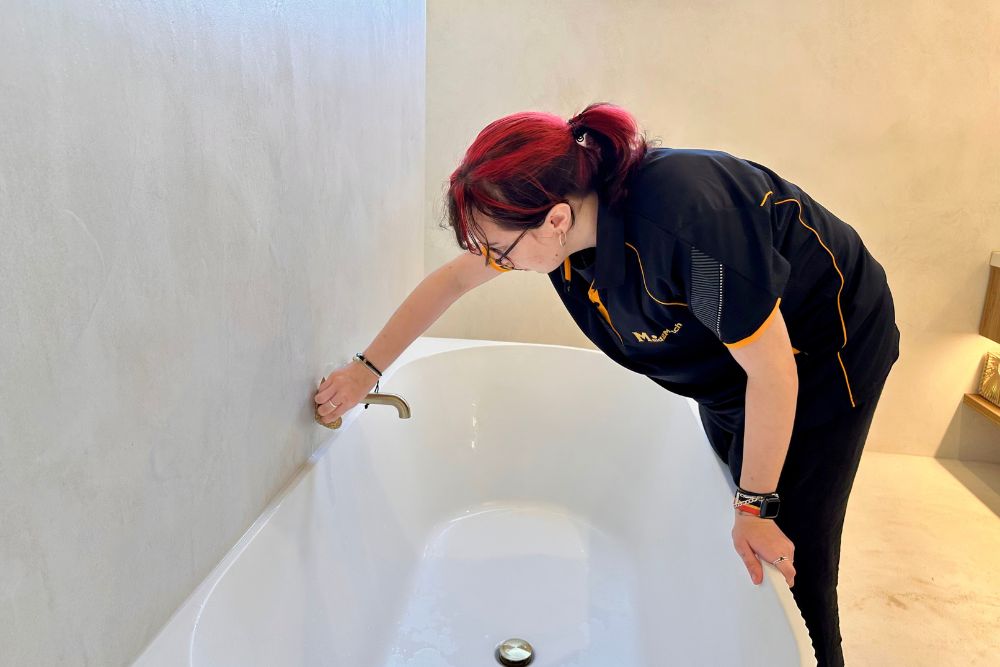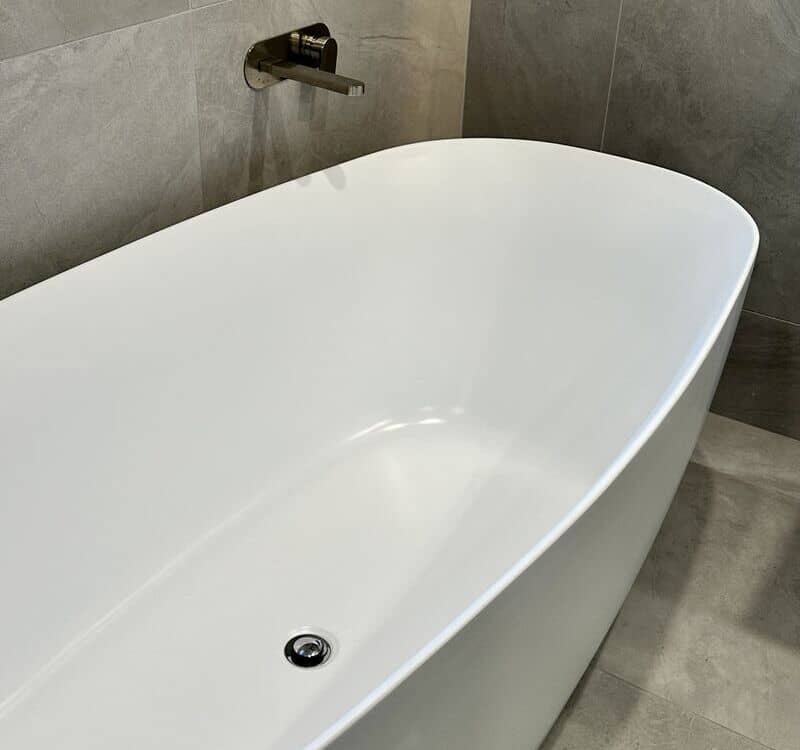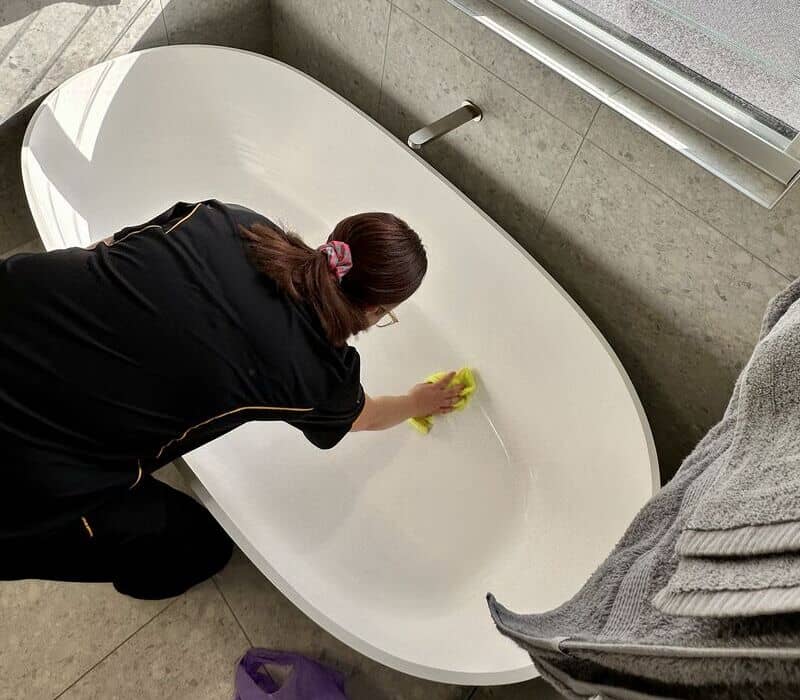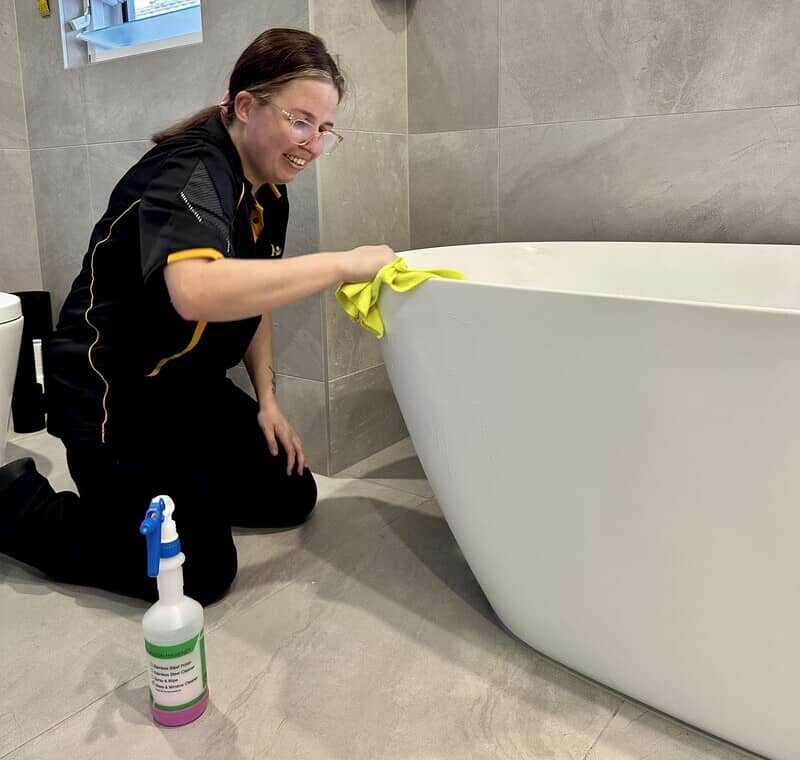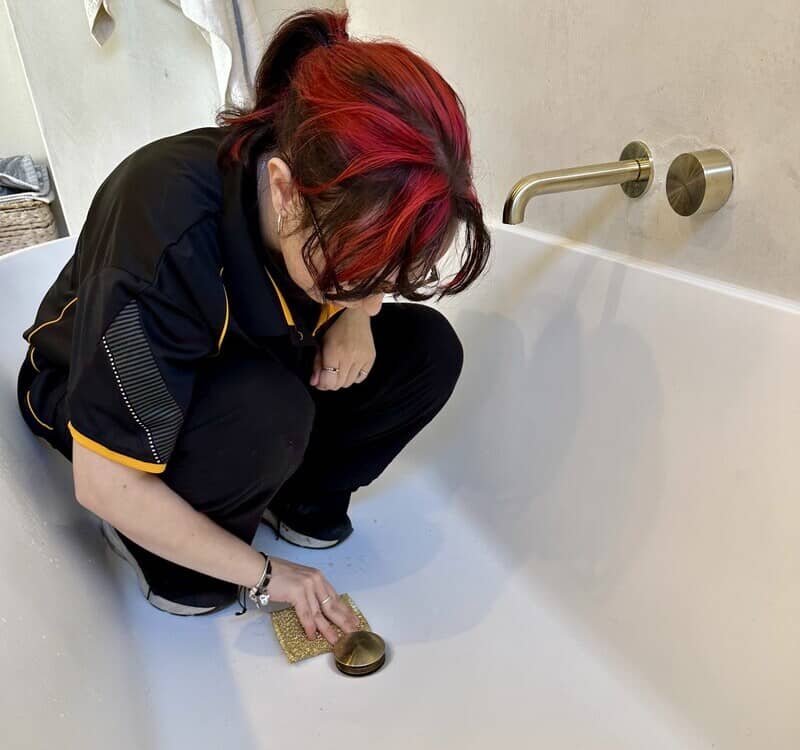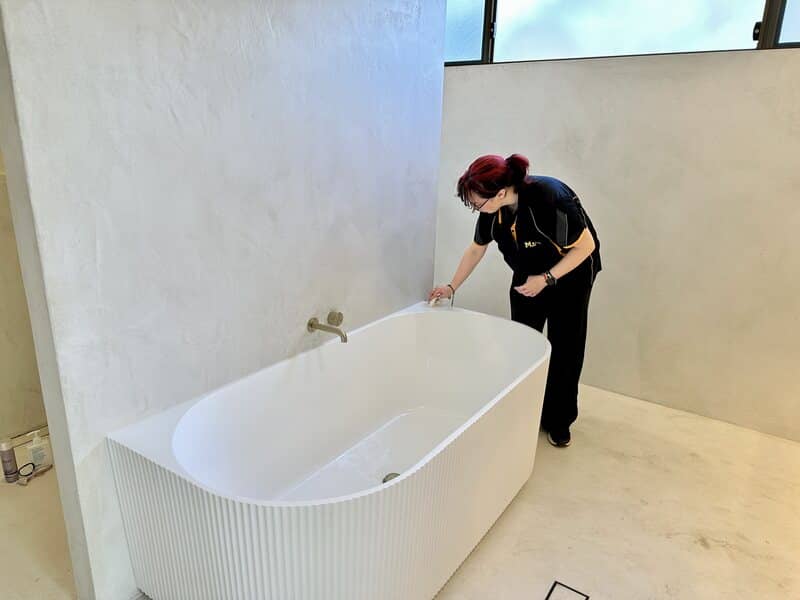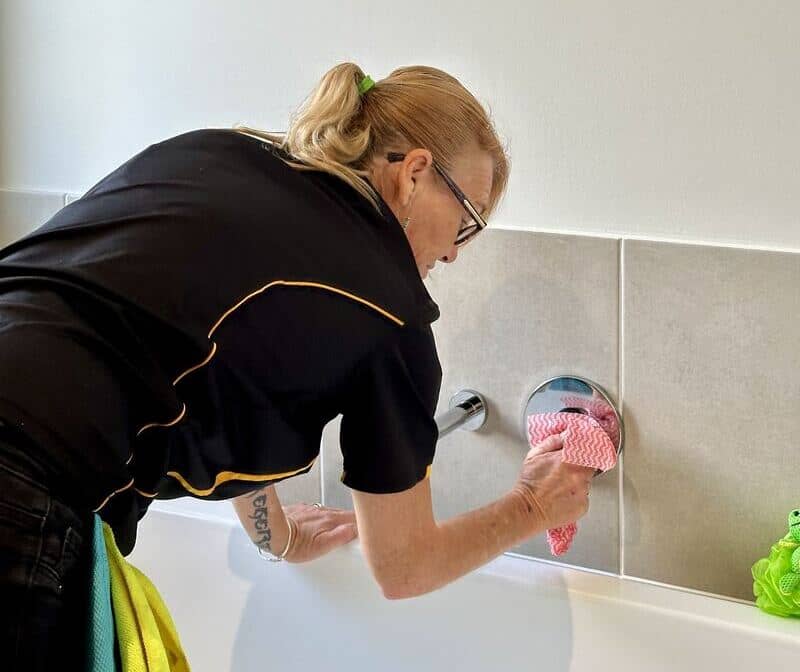It feels so good to step into a bathtub for a nice, hot soak at the end of a long day. You’ve settled in for the ultimate relaxation, and just as you feel yourself unwind… you notice some stains.
A dirty tub can make a bath unrelaxing pretty quickly. Irregular or improper cleaning can lead to a buildup of grime, soap scum, or limescale — or even cause mould or mildew.
The best way to clean a bathtub is to use a soft cloth or sponge and a good non-abrasive cleaner. For most tubs, you can use a mild dish soap, while stone tubs will need a pH-neutral stone cleaner.
Don’t let bathtub blemishes bother your bath time! Here’s how to maintain your tub so you can soak in it stress-free.
How Often to Clean | Before Cleaning | Routine Cleaning | Deep Cleaning | Cleaning a Spa Tub | Bathtub Grout | Bathtub Drain | Removing Stains
Talking About Tubs
From compact corner baths to stylish freestanding tubs, there are a variety of bathtubs to suit every space!
Different materials have their pros and cons — and also cleaning methods.
Acrylic tubs
Acrylic bathtubs are made of lightweight, durable thermoplastic. They’re fairly easy to maintain, but can be prone to scuffing or scratching.
Use mild cleaners like dish soap or a dedicated tub cleaner, and a soft cloth or sponge.
Avoid abrasive materials like scouring powders, which can damage the bathtub surfaces.
Cast iron tubs
Cast iron tubs are typically finished with an enamel coating that resists chipping or scratching. This makes them very durable and long-wearing, but also quite heavy!
They can also rust with improper care, such as with chipped coating.
Enamel is a forgiving material, so as long as the coating is intact, you can use mild cleaners like soap.
For stains, try a thin baking soda paste to scrub the surface.
Fibreglass tubs
Like acrylic, fibreglass bathtubs are lightweight and fairly affordable. However, the material isn’t as durable — fibreglass is prone to fading, scratches, and discolouration.
Use mild, non-abrasive solutions (like soap or vinegar) and soft cloths or sponges.
Stains are trickier to remove, but you can try a vinegar solution or a thick paste of baking soda. Very stubborn stains may require professional refinishing.
Porcelain tubs
These are typically steel tubs with a porcelain coating. They’re sturdy and easy to maintain, but can be prone to stains, especially rust.
For porcelain bathtubs, use gentle cleaners and soft cloths or sponges.
Tackle stains with a little white vinegar (for mineral deposits) or lemon juice (rust).
Stone tubs
Stone bathtubs look great and are very durable, but they’re a bit more high-maintenance than other materials.
Natural stone needs a pH-neutral cleaning solution, like a dedicated stone cleaner. Some options include Weiman Granite Cleaner or Rockstar Stone Care Spray.
Avoid anything acidic, such as vinegar or lemon juice, which can etch and discolour the surfaces.
Follow the product instructions for cleaning, then rinse and dry the tub thoroughly.
How Often to Clean Your Bathtub
If you soak in the tub regularly, do some routine cleaning once a week — about as often as you’d clean the rest of the bathroom.
For those who use the tub less frequently, you can get away with cleaning every few weeks.
Deep clean the tub around once a month.
Don’t want to stress over dirt during a relaxing bath? Leave your bathroom (and the rest of your home) to a Maid2Match cleaner!
Before Cleaning a Tub
Gather your supplies and prep the tub before you start cleaning!
The type of material will determine your cleaning solution, but in general, you’ll need:
- Spray bottle
- Soft-bristled scrubbing brush
- Microfibre cloths or soft sponges
- Non-abrasive cleaner (e.g. mild dish soap)
Avoid abrasive cleaners like steel wool or scouring powders, and harsh chemicals like ammonia or bleach (unless necessary).
Don’t forget to wear rubber gloves and work in a well-ventilated room!
Routine Bathtub Cleaning
Routine maintenance keeps your tub clean and prevents a buildup of stains or residue.
After every use, drain the tub and quickly wipe it dry. Make sure to run the bathroom exhaust or open the windows if you can — that helps limit humidity (which can lead to mould).
Once a week, spray your tub with an appropriate cleaning solution. Rinse it clean with either the shower head or a bucket with water.
Wipe the tub’s surfaces dry to prevent water spots.
Inspect the drain for visible dirt or debris (like strands of hair). Remove any debris, then pour some very hot water down the drain to flush it out.
How to Deep Clean a Bathtub
Before anything else, clear the area around your tub. You’ll need to temporarily move any bottles, soaps, and other items so you can clean all the surfaces.
(This is a good chance to toss out any empty or long-unused products so your bath area isn’t so cluttered!)
Prep your chosen bathtub cleaner beforehand, especially if you need to mix it in a spray bottle.
Gather the rest of your cleaning supplies.
- Stone tubs: pH-neutral or dedicated stone cleaner
- Other tubs: A few drops of mild dish soap in warm water
Quickly rinse the surfaces with a little water. Apply your bathtub cleaner over the entire tub, from the rim to the bottom.
If there are some stains on the surfaces, let the solution sit for 10–20 minutes.
Using a microfibre cloth or soft sponge, scrub the tub’s surfaces thoroughly. Start from the rim (or for alcove-type tubs, the surrounding walls) and work your way downwards.
Don’t forget the fixtures, too! Use the sponge to scrub them clean, then an old toothbrush for any crevices and edges.
If there are hard water spots, dampen a soft cloth with a little white vinegar, then wipe the fixtures clean.
Once you’ve scrubbed the whole tub, rinse everything with the shower head or a bucket. Dry the tub afterwards to prevent water spots.
How to Clean a Spa Bath
Spa baths or jet tubs are a bit more high-maintenance due to all the jet nozzles and drains.
Check if the manufacturer has specific cleaning instructions in the manual — if yes, it’s best to follow those so you don’t damage the rub. They may also have a dedicated cleaning product!
Otherwise, start by running the jets for 10–15 minutes to clear any grime. Once the tub is almost full, stop the jets and drain the water.
For cleaning, opt for a mild dish detergent or a spa bath cleaner. Refill the tub with hot water, up to a little over the jets.
While it’s filling, add 1/8–1/4 cup of detergent, depending on the size of your tub. For spa bath cleaners, use the recommended amount on the package.
Run the jets again for 10 minutes to circulate the cleaning solution. Then drain the tub again before scrubbing the sides with a soft sponge and some more soapy water.
Tackle any stains or stubborn buildup with some vinegar.
Run the tub with clean, cool water to rinse, and wipe it dry to prevent water spots.
How to Clean Bathtub Grout
Tubs built into alcoves, corners, or platforms typically have surrounding tiles and grout. You’ll need to clean these surfaces alongside the bathtub!
Generally, you can use a good-quality tile cleaner that’s safe for both the tile and tub material(s). Follow the product instructions and gently scrub the surfaces clean.
To clean the tub grout, use a grout brush to scrub the lines with soapy water or a thin baking soda paste. Make sure to reseal grout lines every 6 months (or as recommended by the installer).
How to Clean a Bathtub Drain
Hair, soap scum, and other grime will build up around a bathtub drain over time.
To prevent long-term problems (like clogging), you’ll need to deep clean the drain at least once a month.
Regular deep cleaning
Make sure you’re wearing gloves while working!
Inspect the bathtub drain for any debris, such as strands of hair or soap bits. You may need to remove the drain stopper or cover to be thorough.
Pick out the debris by hand and toss it in the rubbish bin. For stuck debris (especially hair), lift it out with a straightened wire hanger or a similar tool.
Pour a kettle of very hot water down the drain in a swirling motion. Use a sponge or scrubbing brush and some soap to scrub the drain mouth clean. Rinse and dry afterwards.
Unclogging a tub drain
If your drain is clogged, and hot water didn’t help, try a commercial drain declogger. Follow the product instructions carefully and work in a well-ventilated room.
Alternatively, you can use a drain snake or plunger to loosen the blockage. If all else fails, call the plumber!
How to Get Rid of Bathtub Stains
You’d think tubs wouldn’t get stained with all that soap and water, but residue, rust, and even mould can cause spots or splotches.
How to remove soap scum from a bathtub
The best way to clean soap scum from a bathtub is a little dish soap and hot water! The heat will help loosen or melt the scum off the surface so it’s easier to remove.
For pink or orange scum, that may be pink mould, which is caused by bacteria called Serratia marcescens. The bacteria thrive in leftover soap scum and can be a health concern.
Tackle pink mould on non-stone tubs by spraying equal parts vinegar and water on the area, then let it sit for at least an hour. Scrub the surface clean, then rinse and dry.
For stone tubs, try 3% hydrogen peroxide or diluted oxygen bleach.
How to clean hard water stains in a bathtub
White vinegar is great for cleaning limescale from hard water. For non-stone tubs, mix equal parts white vinegar and warm water in a spray bottle.
Apply the mixture to the bathtub surfaces and wait 10–20 minutes. Scrub the limescale off with a soft sponge or cloth, then rinse the tub and dry.
For stone bathtubs, stick to a dedicated stone cleaner. Consider installing a water softener, as limescale can be tricky to remove from stone surfaces.
How to get rid of rust stains on a bathtub
If you notice orange stains in the bathtub — especially cast iron or porcelain ones — that’s probably rust!
Sprinkle some salt on the rust stains, then scrub the tub’s surface with a cut lemon. Alternatively, mix lemon juice and salt and apply with a soft sponge.
Leave the solution for 30–60 minutes, then scrub off the rust with a soft cloth or sponge. Rinse the surface and wipe dry.
How to remove mould on a bathtub
Wet, enclosed environments like bathrooms can lead to mould or mildew stains on your tub (ew).
For most tubs, you can get rid of mould using white vinegar or 3% hydrogen peroxide. Vinegar should sit on a surface for at least an hour to effectively kill mould, while peroxide needs at least 10 minutes.
If you have a stone tub, use 3% hydrogen peroxide or diluted oxygen bleach. Follow safety precautions (rubber gloves, face mask, and proper ventilation) and product instructions.
Wash off any residue with soapy water and a sponge, then rinse and dry the tub thoroughly.
FAQs About Bathtub Cleaning
Have additional questions or concerns about cleaning a bathtub? We’ve got you covered!
How do I get my bathtub white again?
White bathtubs look sleek, but any stains or discolouration show up pretty easily. And no one wants to bathe in a dirty-looking tub!
To get a bathtub white again, try scrubbing it clean with some Dawn Powerwash and a soft-bristled brush. Often, this is enough to remove tough dirt and grime.
For stubborn stains and discolouration, consider hydrogen peroxide. Combine it with equal parts warm water, then spray onto the tub and leave for 10 minutes.
Wash the tub with soapy water, then rinse and dry.
If you cannot get fibreglass or acrylic bathtubs white again, they may need to be professionally refinished.
How to disinfect a bathtub without bleach?
If you need to disinfect your bathtub but don’t want to use bleach, use 3% hydrogen peroxide or 70% rubbing alcohol.
Never mix these products with anything but water!
Apply your chosen disinfectant to the tub surfaces and leave for at least 10 minutes. Wash off with soap and water, then dry the tub.
Are freestanding baths hard to clean around?
Yes, freestanding bathtubs can be difficult to clean around, especially if you have limited space between the tub and any surrounding surfaces.
You’ll need a long-handled brush or broom to reach into the narrow spaces and remove any dust or debris. Ditto for a mop so you can wash the surfaces properly.
Moreover, you’ll need to wash the exterior surfaces and mop the floor afterwards so you’re not leaving water everywhere.

